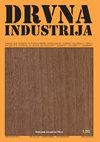Potential Use of Olive Stone Residues in Particleboard Production
IF 0.8
4区 农林科学
Q4 MATERIALS SCIENCE, PAPER & WOOD
引用次数: 0
Abstract
In this study, the effect of using olive stone residues (OSR) on some properties of particleboard was investigated. For this purpose, particle boards were manufactured from particles of white poplar (Populus Alba L.), which were partially substituted with OSR particles in amounts of 10 %, 20 % and 30 %. In addition, boards containing 30 % OSR, which had previously been chemically modified with NaOH solution, were produced. Phenol formaldehyde adhesive was used in the production of the boards. Chemical properties of wood and OSR particles (pH, alcohol benzene solubility, amount of ash), physico-mechanical properties (density, moisture content thickness swelling, modulus of rupture, modulus of elasticity and internal bond strength) and formaldehyde emission values of boards were determined. Water absorption and thickness swelling values were generally decreased with the increase in the use of OSR. When the effect of OSR usage on bending strength, modulus of elasticity, and perpendicular tensile strength values were examined, a decrease in the values was observed except for the 10 % OSR usage ratio. As a result of the application of alkali pretreatment, an increase in thickness swelling values was observed, while the values of mechanical properties increased. Scanning electron microscopy (SEM) analysis results showed more spaces between particles with an increasing OSR usage ratio. Formaldehyde emission values decreased with the increasing amount of OSR. Formaldehyde emission values increased slightly with the application of alkaline pretreatment. Based on the findings of this study, we can conclude that OSR can be used at particularly low ratio in particleboard production.橄榄石残留物在刨花板生产中的潜在用途
研究了橄榄石废渣对刨花板某些性能的影响。为此,颗粒板由白杨(Populus Alba L.)颗粒制成,其被10%、20%和30%的OSR颗粒部分取代。此外,还生产了含有30%OSR的板材,这些板材以前曾用NaOH溶液进行过化学改性。酚醛胶粘剂被用于板材的生产。测定了木材和OSR颗粒的化学性能(pH、醇苯溶解度、灰分)、物理力学性能(密度、含水量、厚度膨胀、断裂模量、弹性模量和内部粘结强度)以及板材的甲醛释放值。吸水率和厚度膨胀值通常随着OSR使用的增加而降低。当检查OSR使用对弯曲强度、弹性模量和垂直拉伸强度值的影响时,除了10%的OSR使用率之外,观察到这些值的降低。由于应用了碱预处理,观察到厚度溶胀值增加,而机械性能值增加。扫描电子显微镜(SEM)分析结果显示,随着OSR使用率的增加,颗粒之间的空间越来越大。甲醛释放值随着OSR用量的增加而降低。甲醛释放值随着碱性预处理的应用略有增加。基于这项研究的结果,我们可以得出结论,OSR可以在刨花板生产中以特别低的比例使用。
本文章由计算机程序翻译,如有差异,请以英文原文为准。
求助全文
约1分钟内获得全文
求助全文
来源期刊

Drvna Industrija
MATERIALS SCIENCE, PAPER & WOOD-
CiteScore
1.80
自引率
9.10%
发文量
32
审稿时长
>12 weeks
期刊介绍:
"Drvna industrija" ("Wood Industry") journal publishes original scientific and review papers, short notes, professional papers, conference papers, reports, professional information, bibliographical and survey articles and general notes relating to the forestry exploitation, biology, chemistry, physics and technology of wood, pulp and paper and wood components, including production, management and marketing aspects in the woodworking industry.
 求助内容:
求助内容: 应助结果提醒方式:
应助结果提醒方式:


